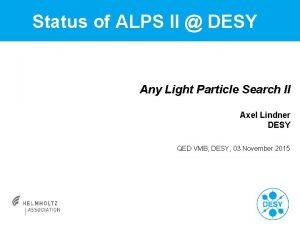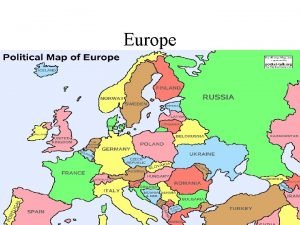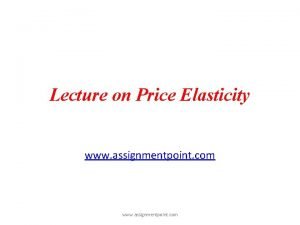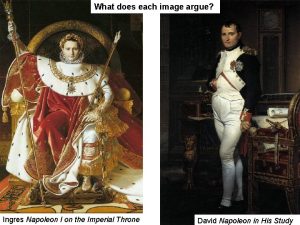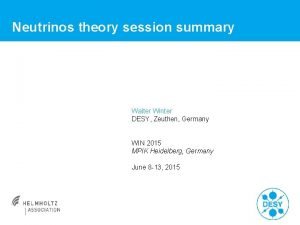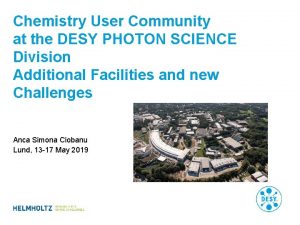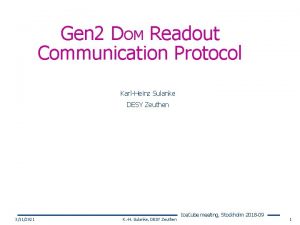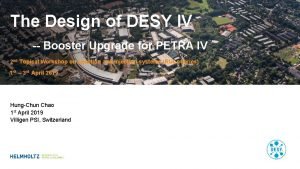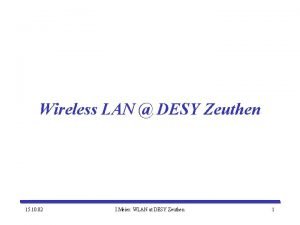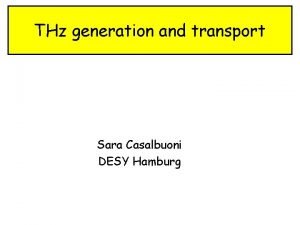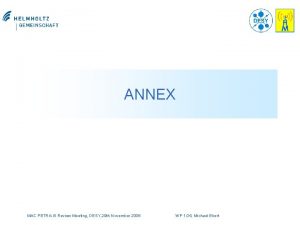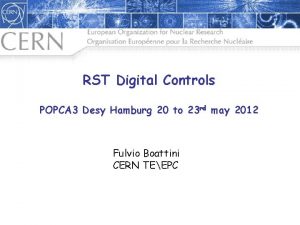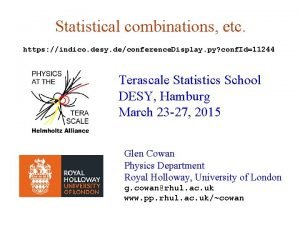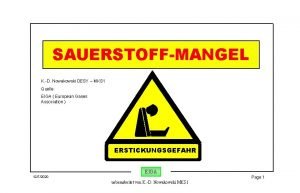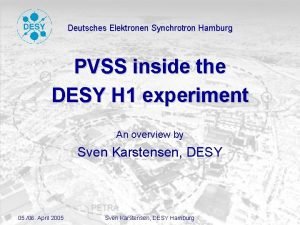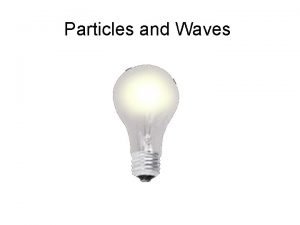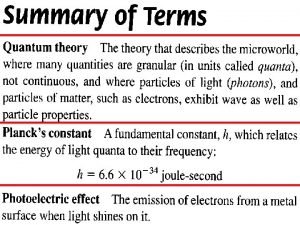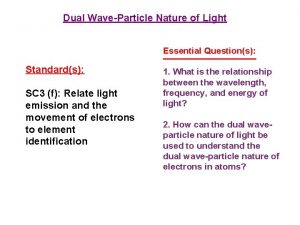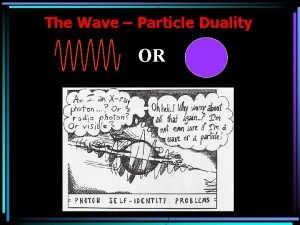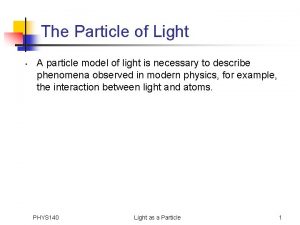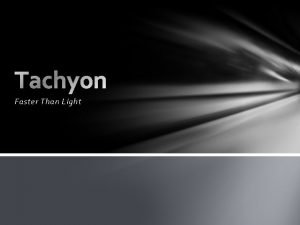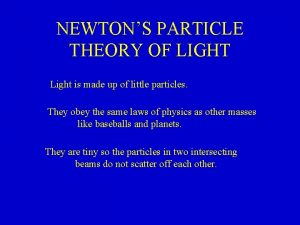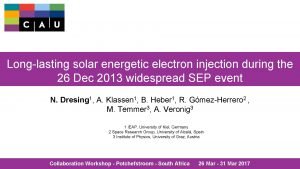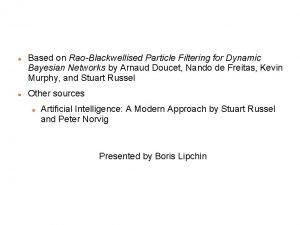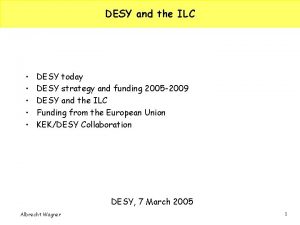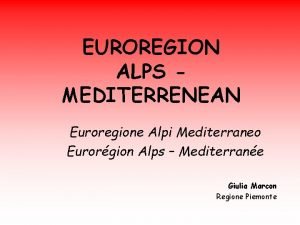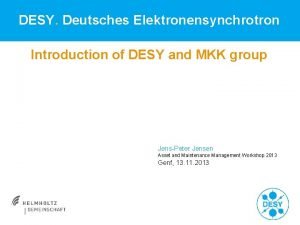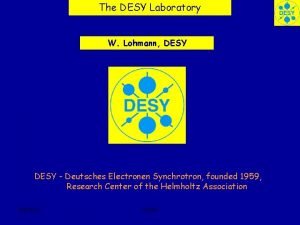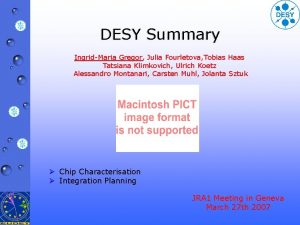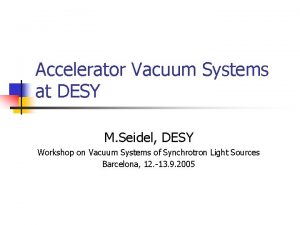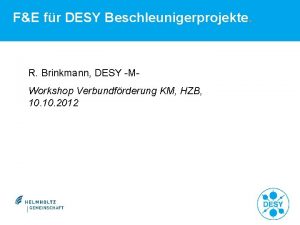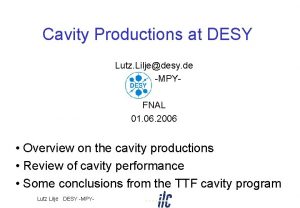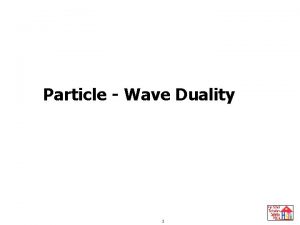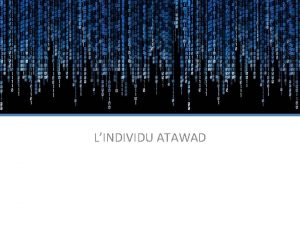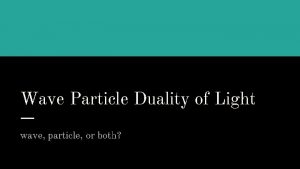Status of ALPS II DESY Any Light Particle


















































- Slides: 50

Status of ALPS II @ DESY Any Light Particle Search II Axel Lindner DESY QED VMB, DESY, 03 November 2015

There is physics beyond the SM > Dark matter and dark energy: (Credit Queens Univ) http: //science. nasa. gov/astrophysics/focus-areas/what-is-dark-energy/ Even if one neglects dark energy: 85% of the matter is of unknown constituents. http: //www. esa. int/For_Media/Photos/Highlights/Planck Axel Lindner | ALPS II | QED VMB | Page 2

There is physics beyond the SM > Dark matter and dark energy candidate constituents: (Credit Queens Univ) http: //science. nasa. gov/astrophysics/focus-areas/what-is-dark-energy/ > Very weak interaction with SMFmatter O S > Very weak interaction among S S! A T M themselves N N UE O T > Stable N on. Tcosmological times I T I S H N O CO >NNon-relativistic DM > Extremely lightweight scalar particle Axel Lindner | ALPS II | QED VMB | Page 3

Introducing today‘s dark matter candidates: WISPs > Weakly Interacting Slim Particles (WISPs) § Theory: WISPs might arise as (pseudo) Goldstone bosons related to extra dimensions in theoretical extensions (like string theory) of the standard model. § Dark matter: in the early universe WISPs are produced in phase transitions and would compose very cold dark matter in spite of their low mass. § Additional benefit: with axions (the longest known WISP) the CP conservation of QCD could be explained, axion-like particles could explain different astrophysical phenomena. > Prediction: Dark matter is composed out of elementary particles with masses below 1 me. V. Its number density is larger than 1012 1/cm 3. Axel Lindner | ALPS II | QED VMB | Page 4

Axions and other WISPs in theory Courtesy A. Ringwald > Axion and other Nambu-Goldstone bosons arising from spontaneous breakdown of global symmetries are theoretically well-motivated very weakly interacting slim (ultra-light) particles. The coefficients are determined by specific ultraviolet extension of SM. A Axel Lindner | ALPS II | QED VMB | Page 5

Axions and other WISPs in theory Courtesy A. Ringwald > Axion and other Nambu-Goldstone bosons arising from spontaneous breakdown of global symmetries are theoretically well-motivated very weakly interacting slim (ultra-light) particles. The coefficients are determined by specific ultraviolet extension of SM. A Axel Lindner | ALPS II | QED VMB | Page 6

> The QCD axion: light, neutral pseudoscalar boson. > The QCD axion: the light cousin of the 0. § Mass and the symmetry breaking scale fa are related: ma = 0. 6 e. V · (107 Ge. V / fa) § The coupling strength to photons is ga = α·g / (π·fa), where g is model dependent and O(1). Note: ga = α·g / (π· 6· 106 Ge. V) · ma § The axion abundance in the universe is Ωa / Ωc (fa / 1012 Ge. V)7/6. fa < 1012 Ge. V ma > μe. V Axel Lindner | ALPS II | QED VMB | Page 7 The Search for Axions, Carosi, van Bibber, Pivovaroff, Contemp. Phys. 49, No. 4, 2008 Properties of the axion

> The QCD axion: light, neutral pseudoscalar boson. > The QCD axion: the light cousin of the 0. § Mass and the symmetry breaking scale fa are related: ma = 0. 6 e. V · (107 Ge. V / fa) § The coupling strength to photons is ga = α·g / (π·fa), where g is model dependent and O(1). Note: ga = α·g / (π· 6· 106 Ge. V) · ma § The axion abundance in the universe is Ωa / Ωc (fa / 1012 Ge. V)7/6. fa < 1012 Ge. V ma > μe. V Axel Lindner | ALPS II | QED VMB | Page 8 The Search for Axions, Carosi, van Bibber, Pivovaroff, Contemp. Phys. 49, No. 4, 2008 Properties of the axion

Other WISPy particles as predicted by theory Weakly Interacting Slim Particles (WISPs): > Axions and axion-like particles ALPs, pseudoscalar or scalar bosons, m and g are not related by an f. > Hidden photons (neutral vector bosons) > Mini-charged particles > Chameleons (self-shielding scalars), massive gravity scalars Axel Lindner | ALPS II | QED VMB | Page 9

Basics of many WISP experiments > Due to their very weak interaction WISPs may traverse any wall opaque to Standard Model constituents (except ν and gravitons). § WISP could transfer energy out of a shielded environment § WISP could convert back into detectable photons behind a shielding. > “Light-shining-through-a-wall” (LSW) steel wall, cryostat, earth’s atmosphere, stellar body, intergalactic background light, …. Okun 1982, Skivie 1983, Ansel‘m 1985, Van Bibber et al. 1987 With the ALP-photon coupling strength g: the experiment measures g 4. Axel Lindner | ALPS II | QED VMB | Page 10

Hints for WISPs / ALPs? > Te. V transparency of the universe? > Cooling of stars? > Indications for a Cosmic Axion-like-particle (ALP) Background (CAB)? ALP mass [e. V] ALP- coupl. [Ge. V-1] Reference Te. V transparency < 10 -7 > 10 -11 ar. Xiv: 1302. 1208 [astro-ph. HE] Globular cluster stars (HB) < 104 5· 10 -11 ar. Xiv: 1406. 6053 [astro-ph. SR] CAB (Coma Cluster) < 10 -13 10 -12 to 10 -13 ar. Xiv: 1406. 5188 [hep-ph] White dwarfs < 10 -2 (gae 5· 10 -13) ar. Xiv: 1304. 7652 [astro-ph. SR] Phenomenon > There allowed regions in parameter space where an ALP can simultaneously explain the gamma ray transparency, the cooling of HB stars, and the soft X-ray excess from Coma and be a subdominant contribution to CDM. Axel Lindner | ALPS II | QED VMB | Page 11

excluded ed d m lud P AL k ar Astrophysics hints r te t a c ex Two photon coupling The big picture: ALPs QCD axion range Excluded by WISP experiments Excluded by astronomy (ass. ALP DM) Excluded by astrophysics / cosmology Axions or ALPs being cold dark matter WISP hints from astrophysics ALP mass Axel Lindner | ALPS II | QED VMB | Page 12

The big picture: ALPs DOI: 10. 1016/j. dark. 2012. 10. 008 e-Print: ar. Xiv: 1210. 5081 [hep-ph] QCD axion range Excluded by WISP experiments Excluded by astronomy (ass. ALP DM) Excluded by astrophysics / cosmology Axions or ALPs being cold dark matter WISP hints from astrophysics Sensitivity of next generation WISP exp. Particular interesting: > ALP-photon couplings around 10 -11 Ge. V-1, masses below 1 me. V. This can be probed by the next generation of experiments. Axel Lindner | ALPS II | QED VMB | Page 13

WISP search strategies > WISPs as Dark Matter, direct: an experiment detects particles of the DM halo all around us. > WISPs as Dark Matter, indirect: an experiment finds astrophysical signatures (next to gravitation) of the DM halo particles. > WISPs in astrophysics: new observational phenomena point at the existence of WISPs (which could be DM candidates). > WISPs in the laboratory: an experiment identifies new particles (which could be DM candidates). DM converts to photons or NMR-like experiments. Signatures for Bose-Einstein condensation of DM WSPs emission might alter the development of stars WISPs pass any shielding Axel Lindner | ALPS II | QED VMB | Page 14

WISP search strategies > WISPs as Dark Matter, direct: an experiment detects particles of the DM halo all around us. > WISPs as Dark Matter, indirect: an experiment finds astrophysical signatures (next to gravitation) of the DM halo particles. > WISPs in astrophysics: new observational phenomena point at the existence of WISPs (which could be DM candidates). > WISPs in the laboratory: an experiment identifies new particles (which could be DM candidates). DM converts to photons or see CASPEr. Signatures for Bose-Einstein condensation of DM WSPs emission might alter the development of stars WISPs pass any shielding Axel Lindner | ALPS II | QED VMB | Page 15

Searching for WISPs in the laboratory Weakly Interacting Slim Particles (WISPs) are searched for by > Purely laboratory experiments (“light-shining-through-walls”) optical photons, > Helioscopes (WISPs emitted by the sun), X-rays. Axel Lindner | ALPS II | QED VMB | Page 16

Searching for WISPs in the laboratory Weakly Interacting Slim Particles (WISPs) are searched for by > Purely laboratory experiments (“light-shining-through-walls”) optical photons, ga , JP, m (estimation) > Helioscopes (WISPs emitted by the sun), X-rays. flux·ga , J(P), m (estimation) Axel Lindner | ALPS II | QED VMB | Page 17

Searching for WISPs in the laboratory Weakly Interacting Slim Particles (WISPs) are searched for by > Purely laboratory experiments (“light-shining-through-walls”) optical photons, ga , JP, m (estimation) > Helioscopes (WISPs emitted by the sun), X-rays. flux·ga , J(P), m (estimation) Axel Lindner | ALPS II | QED VMB | Page 18

Purely laboratory experiments Axel Lindner | ALPS II | QED VMB | Page 19

ALPS @ DESY in Hamburg PETRA III-Extension I HI PETRA III CFEL FLASH ALPS I AS MPI CSSB FL CHy. N European XFEL ALPS II in the HERA tunnel? PETRA III-Extension Axel Lindner | ALPS II | QED VMB | Page 20

ALPS I 2007 -2010 (PLB Vol. 689 (2010), 149, or http: //arxiv. org/abs/1004. 1313) > Unfortunately, no light was shining through the wall! laser hut HERA dipole 3. 5· 1021 1/s detector < 10 -3 1/s > The most sensitive WISP search experiment in the laboratory (up to 2014). Axel Lindner | ALPS II | QED VMB | Page 21

The ALPS II challenge > Improve sensitivity for g, the ALPS-photon coupling strength, by > 1, 000. The experiment measures a rate ~ g 4: > The experimental sensitivity is to increased by a factor 1012! Axel Lindner | ALPS II | QED VMB | Page 22

laser hut > Laser with optical cavity to recycle laser power, switch from 532 nm to 1064 nm, increase effective power from 1 to 150 k. W. HERA dipole > Magnet: upgrade to 10+10 straightened HERA dipoles instead of ½+½ used for ALPS I. detector > Regeneration cavity to increase WISP-photon conversions, single photon counter (superconducting transition edge sensor). Axel Lindner | ALPS II | QED VMB | Page 23 All set up in a clean environment! Prospects for ALPS II @ DESY

ALPS II essentials: laser & optics ALPS I: basis of success was the optical resonator in front of the wall. > ALPS IIa Optical resonator to increase effective light flux by recycling the laser power Optical resonator to increase the conversion probability WISP→ First realization of a 24 year old proposal! Axel Lindner | ALPS II | QED VMB | Page 24

The ALPS II challenge > Photon regeneration probability: > ALPS II: § FPC = 5000, FRC = 40000 (power build-up in the optical resonators) § B = 5. 3 T, l = 88 m P = 3. 5· 10 -24 for g=5· 10 -11 Ge. V-1 (compare the ALPS I limit: 1· 10 -11 for g=7· 10 -8 Ge. V-1) § With a laser power of 30 W (1064 nm): expected photon rates: dn/dt = 2. 0 h-1 for g=5· 10 -11 Ge. V-1 (compare the ALPS I limit: 2· 109 s-1 for g=7· 10 -8 Ge. V-1) Axel Lindner | ALPS II | QED VMB | Page 25

ALPS II is realized in stages ALPS I > ALPS IIa > ALPS IIc Axel Lindner | ALPS II | QED VMB | Page 26

ALPS II optics Production cavity, infrared Wall Regeneraton cavity, locked with green light. Axel Lindner | ALPS II | QED VMB | Page 27

ALPS II optics Production cavity, infrared Wall Regeneraton cavity, locked with green light. Axel Lindner | ALPS II | QED VMB | Page 28

ALPS II optics Production cavity, infrared Wall Regeneraton cavity, locked with green light. Axel Lindner | ALPS II | QED VMB | Page 29

ALPS II optics > Pound-Drever hall “locking“ to compensate for seismic noise fluctuations. ok > Differential wavefront sensing for auto-aligning the optical axis of the cavity. (ok) Axel Lindner | ALPS II | QED VMB | Page 30

ALPS II optics > Generate and adapt 532 nm light to control the regeneration cavity behind the wall. (ok) Axel Lindner | ALPS II | QED VMB | Page 31

ALPS II optics > Feed 532 nm light into the regeneration cavity with “perfect” filtering out 1064 nm light. (ok) Axel Lindner | ALPS II | QED VMB | Page 32

ALPS II optics > Pound-Drever hall “locking“ to compensate for seismic noise fluctuations. (ok) > Differential wavefront sensing for auto-aligning the optical axis of the cavity. (ok) Axel Lindner | ALPS II | QED VMB | Page 33

ALPS II optics > Design and build central breadboard with two flat mirrors fixed and aligned to an accuracy better than 10 µrad. (ok) Axel Lindner | ALPS II | QED VMB | Page 34

ALPS II optics > Guide 1064 nm signal photons into the detector with “perfect” filtering out 532 nm light. (ok) Axel Lindner | ALPS II | QED VMB | Page 35

The photon source The laser has been developed for LIGO: 35 W, 1064 nm, M 2<1. 1 based on 2 W NPRO by Innolight/Mephisto (Nd: YAG (neodymiumdoped yttrium aluminium garnet) Axel Lindner | ALPS II | QED VMB | Page 36

The central optics 0, 0006 mm Axel Lindner | ALPS II | QED VMB | Page 37

ALPS II detector Transition Edge Sensor (TES) Axel Lindner | ALPS II | QED VMB | Page 38

ALPS II detector Transition Edge Sensor (TES) ΔT = 100 µK Axel Lindner | ALPS II | QED VMB | Page 39

ALPS II detector Transition Edge Sensor (TES) ΔT 100 µK ΔR 1 Ω ΔI 70 n. A Axel Lindner | ALPS II | QED VMB | Page 40

ALPS II detector Transition Edge Sensor (TES) ΔT 100 µK ΔR 1 Ω ΔI 70 n. A > Expectation: very high quantum efficiency, also at 1064 nm, very low noise. Axel Lindner | ALPS II | QED VMB | Page 41

ALPS II: Transition Edge Sensor (TES) 25 x 25 µm 2 8 µm Axel Lindner | ALPS II | QED VMB | Page 42

ALPS II: Transition Edge Sensor (TES) > Tungsten film kept at the transition to superconductivity at 80 m. K. > Sensor size 25µm x 20 nm. > Single 1066 nm photon pulses! > Energy resolution 8%. > Dark background 10 -4 counts/second. > Ongoing: background studies, optimize fibers, minimize background from ambient thermal photons. Axel Lindner | ALPS II | QED VMB | Page 43

ALPS II schedule (rough) 2015 ALPS IIa 2016 2017 2018 2019 Install. (without magnets) Runs risk assessments ALPS IIc Closure of the LINAC tunnel of the European XFEL under construction at DESY. ALPS IIa today ALPS IIc in 2018 in the HERA tunnel Axel Lindner | ALPS II | QED VMB | Page 44

ALPS II schedule (rough) Latest input from QED VMB studies on the ALPS IIc design! 2015 ALPS IIa 2016 2017 2018 2019 Install. (without magnets) Runs risk assessments ALPS IIc Closure of the LINAC tunnel of the European XFEL under construction at DESY. ALPS IIa today ALPS IIc in 2018 in the HERA tunnel Axel Lindner | ALPS II | QED VMB | Page 45

The axion-like particle landscape Axel Lindner | ALPS II | QED VMB | Page 46

ALPS II sensitivity > Well beyond current limits. > Aim for data taking in 2018. ALPS II > QCD axions not in reach. > Able to probe hints from astrophysics. Axel Lindner | ALPS II | QED VMB | Page 47

The ALPS collaboration ALPS II is a joint effort of > DESY, > Hamburg University, > AEI Hannover (MPG & Hannover Uni. ), > Mainz University, > University of Florida (Gainesville) with strong support from > neo. LASE, PTB Berlin, NIST (Boulder), AIST (Japan). Axel Lindner | ALPS II | QED VMB | Page 48

Summary > The axion “invented” to explain the CP-conservation in QCD is also a perfect and extremely lightweight cold dark matter candidate. > In addition to axions theory predicts axion-like particles (ALPs) as well as other Weakly Interacting Slim Particles (WISPs). § Such ALPs and other WISPs might also constitute the dark matter. § Astrophysics phenomena might point at the existence of WISPs. > ALPS II has a sufficient sensitivity to discover axion-like particles or other WISPs, especially in the region hinted at by astrophysics. ALPS II could hint at dark matter candidate particles! > Small scale and short term WISP experiments offer a fascinating complement to accelerator based “big science”. > There is plenty of room for new ideas and quick experiments having the potential to change the (particle physicist’s) world! Axel Lindner | ALPS II | QED VMB | Page 49

… in the unlikely case … … that ALPS IIc only improves limits on the existence of WISPs: It would be fantastic if we could use the investments into the ALPS IIc infrastructure to measure the QED VMB effect. Thank you all for coming and contributing with presentations and discussions. Axel Lindner | ALPS II | QED VMB | Page 50
 Alps desy
Alps desy Chapter 22
Chapter 22 Light light light chapter 23
Light light light chapter 23 Light light light chapter 22
Light light light chapter 22 Napoleon crossing the alps romanticism
Napoleon crossing the alps romanticism Ural mountains map europe
Ural mountains map europe Alps connect
Alps connect Ashlar arch
Ashlar arch Grande odalisque
Grande odalisque Physical features of northern ireland
Physical features of northern ireland The wedding analysis
The wedding analysis This breed originated in french alps
This breed originated in french alps How to calculate income elasticity of demand
How to calculate income elasticity of demand Napoleon bonaparte ambition
Napoleon bonaparte ambition Ural.mountains map
Ural.mountains map Napoleon crossing the alps
Napoleon crossing the alps Helen frankenthaler mountains and sea
Helen frankenthaler mountains and sea Walter winter desy
Walter winter desy Desy photon science
Desy photon science Desy sax
Desy sax Desy summer student program
Desy summer student program Bf desy
Bf desy Desy wifi
Desy wifi Desy transport
Desy transport Michael ebert desy
Michael ebert desy Popca t
Popca t Indico desy
Indico desy Quelle
Quelle Desy hostel
Desy hostel Desy summer student
Desy summer student Desy wap
Desy wap Proposed the particle theory of light
Proposed the particle theory of light Light is a particle evidence
Light is a particle evidence Light behaves primarily as a particle when it
Light behaves primarily as a particle when it Photon
Photon The particle model describes light as
The particle model describes light as Full wavelength
Full wavelength Particle model of light
Particle model of light Tachyon theorized
Tachyon theorized Particle theory of light
Particle theory of light There isn't any pasta
There isn't any pasta Any to any connectivity
Any to any connectivity Seknder
Seknder Dts receiver programming
Dts receiver programming Dts expert 500 manual
Dts expert 500 manual Leucoplast double membrane
Leucoplast double membrane The bouncing off of light
The bouncing off of light Materials that blocks light
Materials that blocks light Put out the light and put out the light
Put out the light and put out the light Energetic particle
Energetic particle Rao blackwell particle filter
Rao blackwell particle filter
